Improved Wallis Dodging Algorithm for Large-Scale Super-Resolution Reconstruction Remote Sensing Images
Abstract
:1. Introduction
2. Methodology
2.1. Super-Resolution Reconstruction
2.2. Wallis Dodging
2.3. Seam Elimination
3. Improved Wallis Dodging
4. Experimental Results and Discussion
4.1. Image SR Reconstruction
4.2. Experiments of Different Dodging Algorithms
4.3. Comparative Experiment on 64 Images
4.4. Experiment on 900 Images
5. Conclusions
Acknowledgments
Author Contributions
Conflicts of Interest
References
- Park, S.C.; Park, M.K.; Kang, M.G. Super-resolution image reconstruction: A technical overview. IEEE Signal Process. Mag. 2003, 20, 21–36. [Google Scholar] [CrossRef]
- Chaudhuri, S.; Manjunath, J. Motion-Free Super-Resolution; Springer Science & Business Media: Berlin, Germany, 2006. [Google Scholar]
- Shen, H.F.; Li, P.X.; Zhang, L.P. Overview on super resolution image reconstruction. Opt. Tech. 2009, 35, 194–199. [Google Scholar]
- Wang, M. The Development of Large-Scale Seamless Image Database (GeoImageDB) and the Feasible Research on Measurable Virtual Reality. Ph.D. Thesis, LIESMARS, Wuhan University, Wuhan, China, 2001. [Google Scholar]
- Koh, Y.W.; Celik, T.; Lee, H.K. Detection of meibomian glands and classification of meibography images. J. Biomed. Opt. 2012, 17, 0860081–0860087. [Google Scholar] [CrossRef] [PubMed]
- Li, D.R.; Wang, M.; Pan, J. Auto-dodging processing and its application for optical RS images. Geomatics Inf. Sci. Wuhan Univ. 2006, 31, 753–756. [Google Scholar]
- Orsini, G.; Ramponi, G.; Carrai, P. A modified Retinex for image contrast enhancement and dynamics control. In Proceedings of the 2003 International Conference on Image Processing, Barcelona, Spain, 14–17 September 2003.
- Wong, A.; Clausi, D.A.; Fieguth, P. Adaptive monte carlo retinex method for illumination and reflectance separation and color image enhancement. In Proceedings of the 2009 Canadian Conference on Computer and Robot Vision, Kelowna, BC, Canada, 25–27 May 2009; pp. 108–115.
- Pan, X.B.; Brady, M.; Bowman, A.K. Enhancement and feature extraction for images of incised and ink texts. Image Vision Comput. 2004, 22, 443–451. [Google Scholar] [CrossRef]
- Jiménez-Sánchez, A.R.; Mendiola-Santibañez, J.D.; Terol-Villalobos, I.R. Morphological background detection and enhancement of images with poor lighting. IEEE Trans. Image Process. 2009, 18, 613–623. [Google Scholar] [CrossRef] [PubMed]
- Yeganeh, H.; Ziaei, A.; Rezaie, A. A novel approach for contrast enhancement based on histogram equalization. In Proceedings of the 2008 International Conference on Computer and Communication Engineering, Hotel Istana, Kuala Lumpur, Malaysia, 13–15 May 2008; pp. 256–260.
- Kim, M.; Chung, M.G. Recursively separated and weighted histogram equalization for brightness preservation and contrast enhancement. IEEE Trans. Consum. Electron. 2008, 54, 1389–1397. [Google Scholar] [CrossRef]
- Arici, T.; Dikbas, S.; Altunbasak, Y. A histogram modification framework and its application for image contrast enhancement. IEEE Trans. Image Process. 2009, 18, 1921–1935. [Google Scholar] [CrossRef] [PubMed]
- Zhang, G.; Chen, Q.; Sun, Q. Illumination normalization among multiple remote-sensing images. IEEE Geosci. Remote Sens. Lett. 2014, 11, 1470–1474. [Google Scholar] [CrossRef]
- Zhang, L.; Zhang, Z.; Zhang, J. The image matching based on wallis filtering. J. Wuhan Tech. Univ. Surv. Mapp. 1999, 1, 24–35. [Google Scholar]
- Wang, M.; Pan, J. A new color balance method for large-scale seamless image database. Remote Sens. Land Resour. 2006, 4, 10–13. [Google Scholar]
- Zhang, D.R.; Yu, L.; Zhang, H.K. Fast mosaic method for optical remote sensing images. J. Zhejiang Univ. (Eng. Sci.) 2009, 11, 1988–1993. [Google Scholar]
- Zou, L.Y.; Qin, Z.Y.; Shang, W. Image Contrast Dodging Algorithm of Maintaining Consistency. J. Geomatics Sci. Technol. 2011, 1, 13. [Google Scholar]
- Wang, G.Y.; Zhang, H.S. Research on Wallis-dodging algorithm for cartography. Technol. Innov. Appl. 2014, 22, 32–33. [Google Scholar]
- Chen, K.; Huang, T.Y.; Wen, P. Research on establishment of seamless DOM image database with color consistency using dodging and uniform color. Eng. Surv. Mapp. 2014, 23, 66–69. [Google Scholar]
- Luo, S. Improved Dodging Algorithm Based on Wallis Principle. Geomat. Sci. Technol. 2015, 3, 51–58. [Google Scholar] [CrossRef]
- Tian, J.; Li, X.; Duan, F. An Efficient Seam Elimination Method for UAV Images Based on Wallis Dodging and Gaussian Distance Weight Enhancement. Sensors 2016, 16, 662. [Google Scholar] [CrossRef] [PubMed]
- Tian, J.; Ma, K.K. A survey on super-resolution imaging. Signal Image Video Process. 2011, 5, 329–342. [Google Scholar] [CrossRef]
- Chaudhuri, S. Super-Resolution Imaging; Springer Science & Business Media: Berlin, Germany, 2001. [Google Scholar]
- Cristóbal, G. Multiframe blind deconvolution coupled with frame registration and resolution enhancement. Blind Image Deconvolution Theor. Appl. 2007, 3, 317. [Google Scholar]
- Yi, Y.; Gong, J.; Wang, G. Hue adjustment method of large-scale image database. Geomat. Inf. Sci. Wuhan Univ. 2003, 28, 311–314. [Google Scholar]
- Zhu, S.; Qian, Z. The seam line removal under mosaicking of remotely sensed images. J. Remote Sens. Beijing 2002, 6, 187–191. [Google Scholar]
- Zhang, Y.H.; Lin, Z.J.; Zhang, J.X. An Image Mosaicing Approach Based on Image Matching and Adjustment. J. Image Graph. 2001, 4, 8. [Google Scholar]
- Du, Y.; Cihlar, J.; Beaubien, J. Radiometric normalization, compositing, and quality control for satellite high-resolution image mosaics over large areas. IEEE Trans. Geosci. Remote Sens. 2001, 39, 623–634. [Google Scholar]
- Wang, J. Image Mosaicking and its Edge Processing. Pattern Recogn. Artif. Intell. 1993, 6, 189–195. [Google Scholar]
- Zhu, S.L.; Yang, X. The seamline removing in the generation of orthophoto maps. Int. Arch. Photogramm. Remote Sens. 2000, 33, 1247–1251. [Google Scholar]
- Peleg, S. Elimination of seams from photomosaics. Comput. Graphics Image Process. 1981, 16, 90–94. [Google Scholar] [CrossRef]
- Dijkstra, E.W. A note on two problems in connexion with graphs. Numerische Math. 1959, 1, 269–271. [Google Scholar] [CrossRef]
- Davis, J. Mosaics of scenes with moving objects. In Proceedings of the 1998 IEEE Computer Society Conference on Computer Vision and Pattern Recognition, Santa Barbara, CA, USA, 23–25 June 1998; pp. 354–360.
- Chon, J.; Kim, H.; Lin, C.S. Seam line determination for image mosaicking: A technique minimizing the maximum local mismatch and the global cost. ISPRS J. Photogramm. Remote Sens. 2010, 65, 86–92. [Google Scholar] [CrossRef]
- Avidan, S.; Shamir, A. Seam carving for content-aware image resizing. ACM Trans. Graphics (TOG) 2007, 26, 10. [Google Scholar] [CrossRef]
- Pan, J.; Wang, M.; Li, D. Automatic generation of seamline network using area Voronoi diagrams with overlap. IEEE Trans. Geosci. Remote Sens. 2009, 47, 1737–1744. [Google Scholar] [CrossRef]
- Wan, Y.; Wang, D.; Xiao, J. Tracking of vector roads for the determination of seams in aerial image mosaics. IEEE Geosci. Remote Sens. Lett. 2012, 9, 328–332. [Google Scholar] [CrossRef]
- Jia, J.; Tang, C.K. Eliminating structure and intensity misalignment in image stitching. In Proceedings of the 2005 IEEE 10th International Conference on Computer Vision, Beijing, China, 15–21 October 2005; Volume 1, pp. 1651–1658.
- Gracias, N.; Mahoor, M.; Negahdaripour, S. Fast image blending using watersheds and graph cuts. Image Vision Comput. 2009, 27, 597–607. [Google Scholar] [CrossRef]
- Zuo, Z.Q.; Zhang, Z.X.; Zhang, J.Q. Seam line intelligent detection in large urban orthoimage mosaicking. Acta Geod. Cartgraph. Sin. 2011, 40, 84–89. [Google Scholar]
- Wan, Y.; Wang, D.; Xiao, J. Automatic determination of seamlines for aerial image mosaicking based on vector roads alone. ISPRS J. Photogramm. Remote Sens. 2013, 76, 1–10. [Google Scholar] [CrossRef]
- Ma, H.; Sun, J. Intelligent optimization of seam line finding for orthophoto mosaicking with LiDAR point clouds. J. Zhejiang Univ. Sci. C 2011, 12, 417–429. [Google Scholar] [CrossRef]


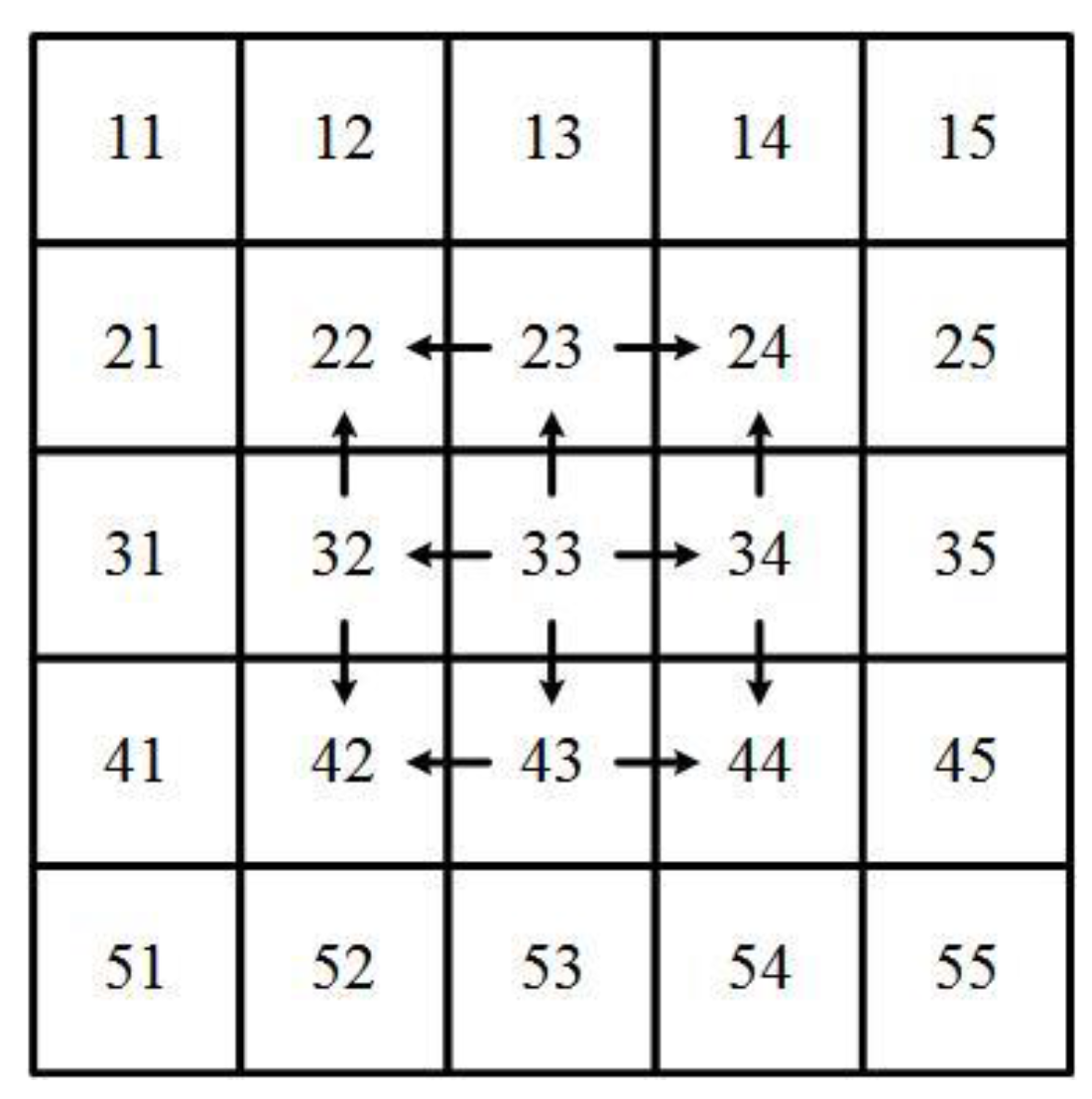

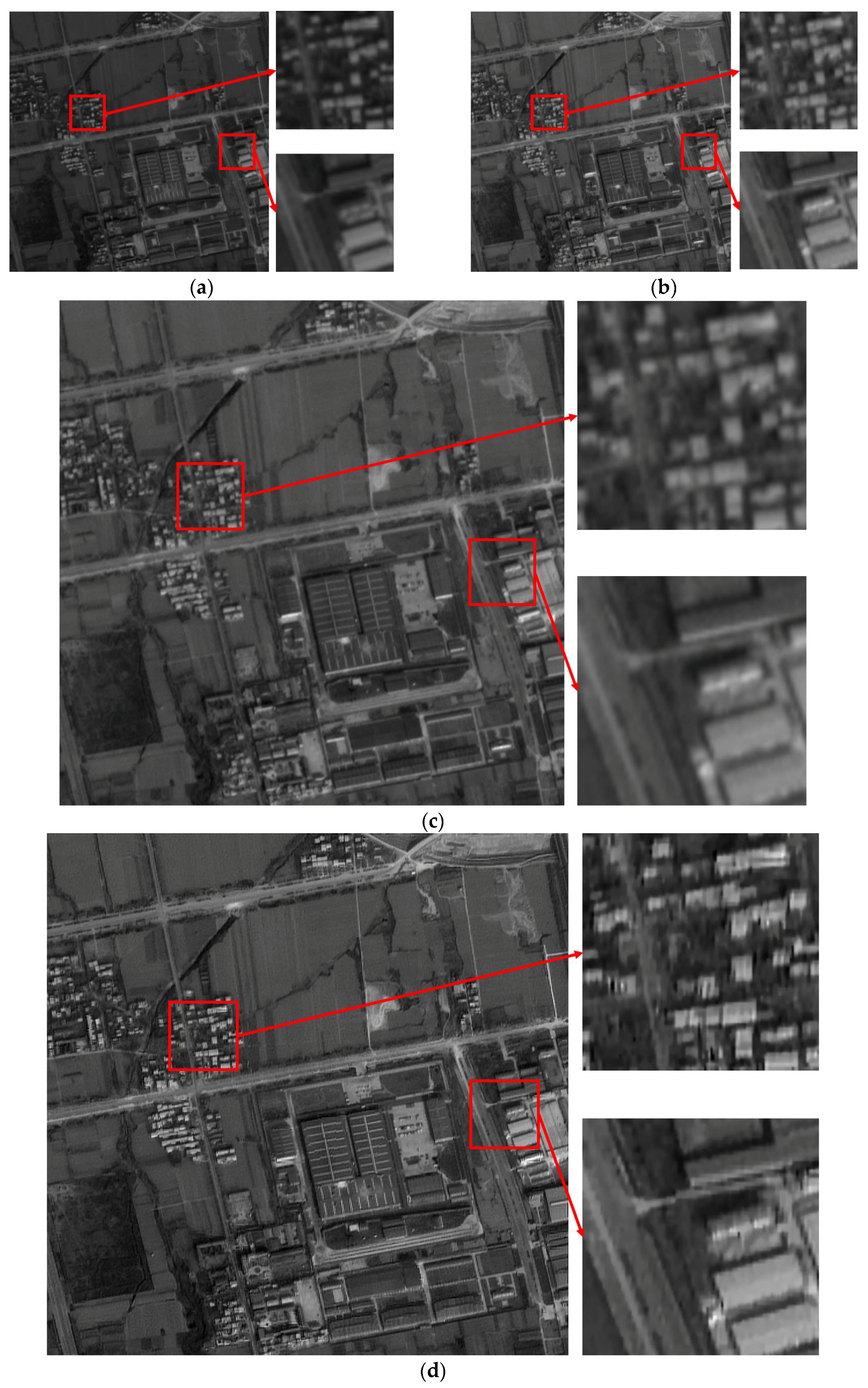
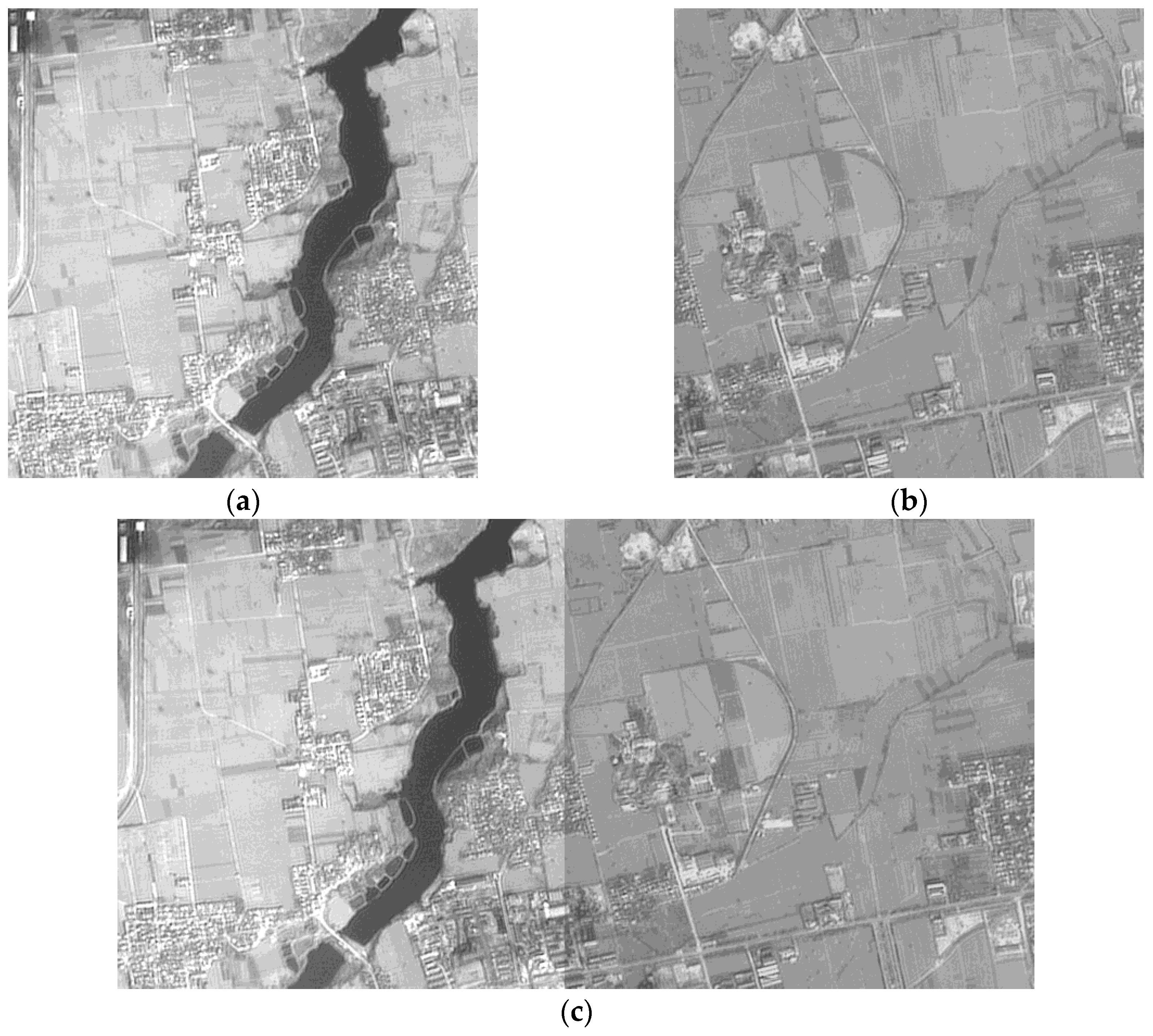
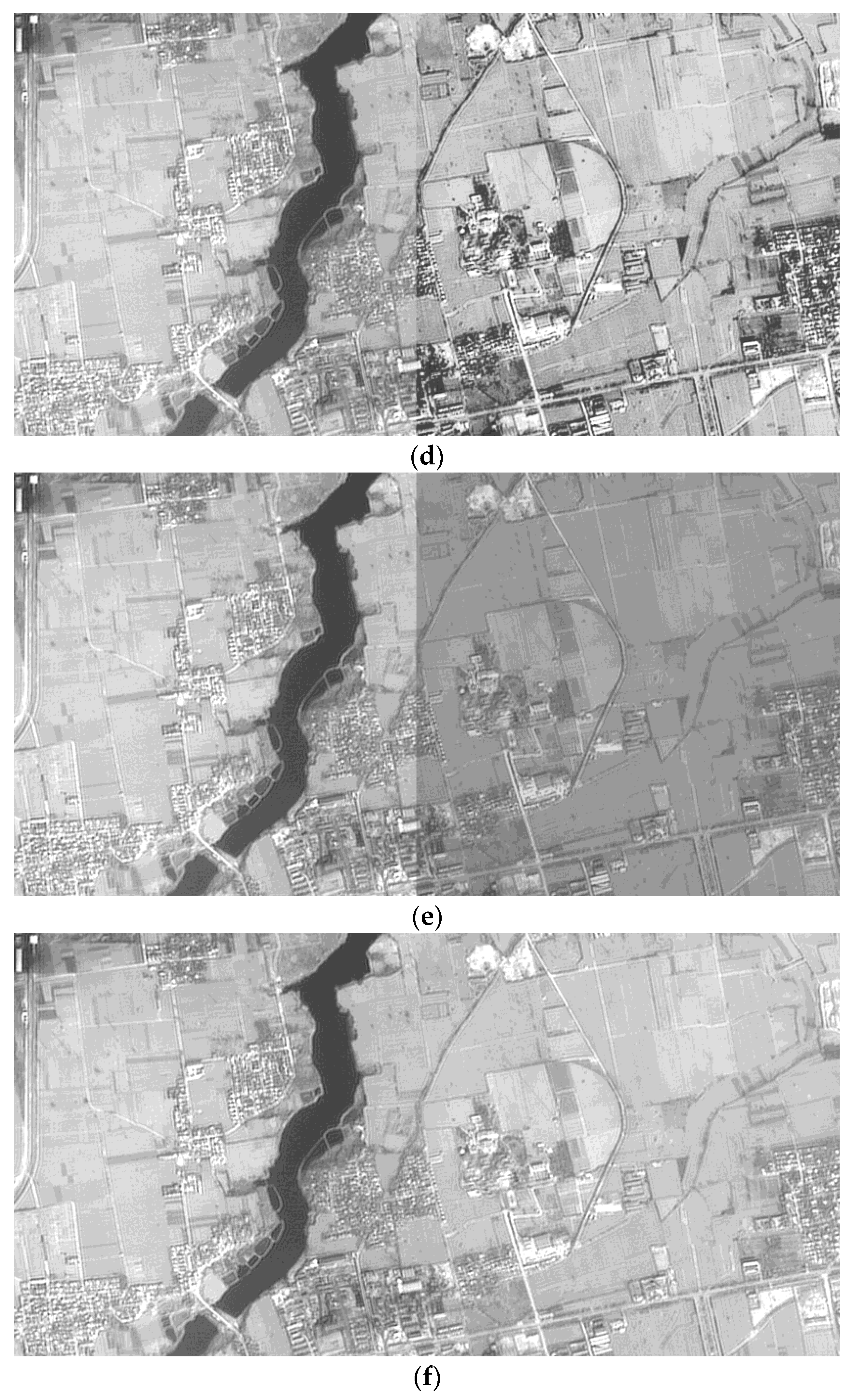
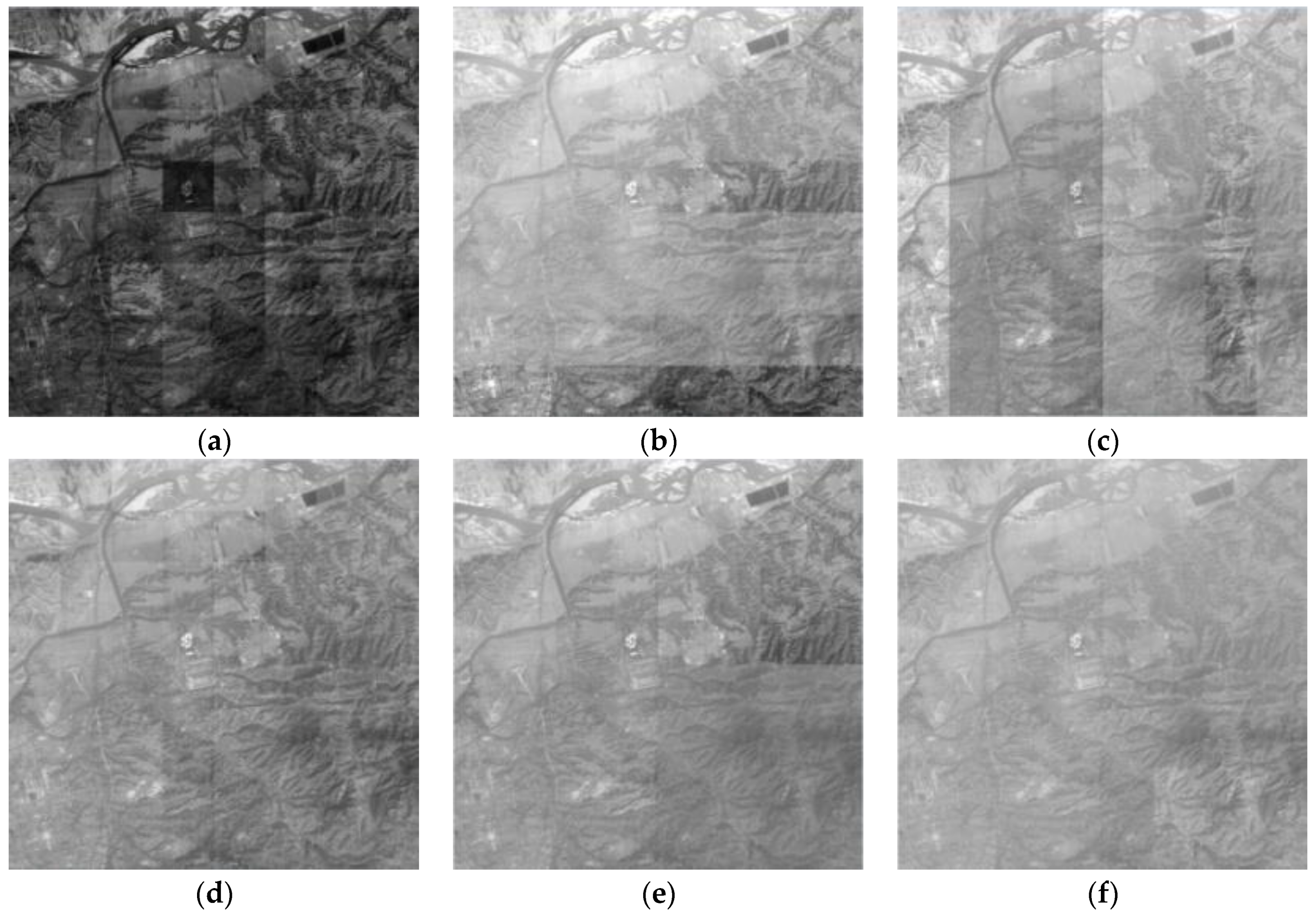
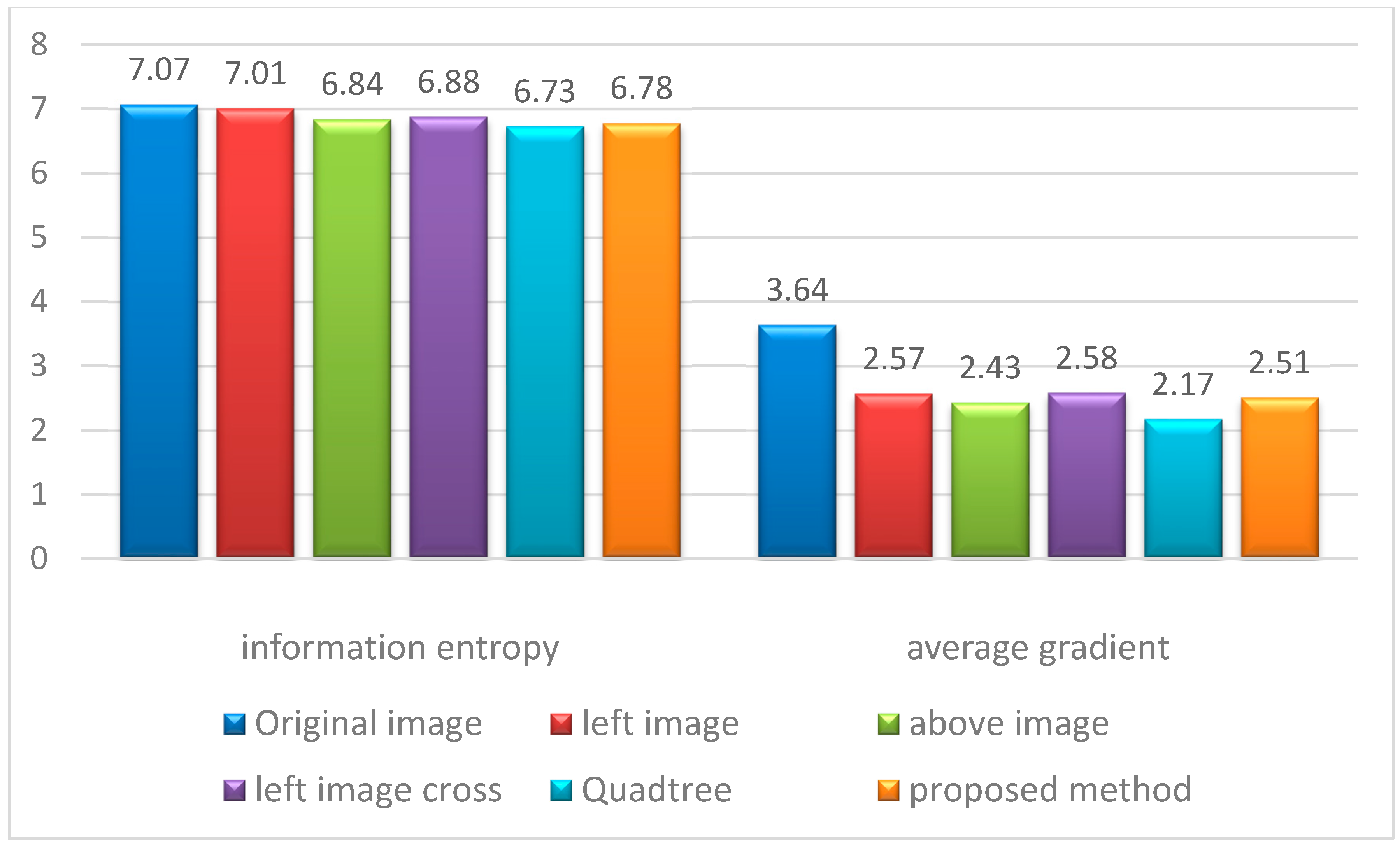
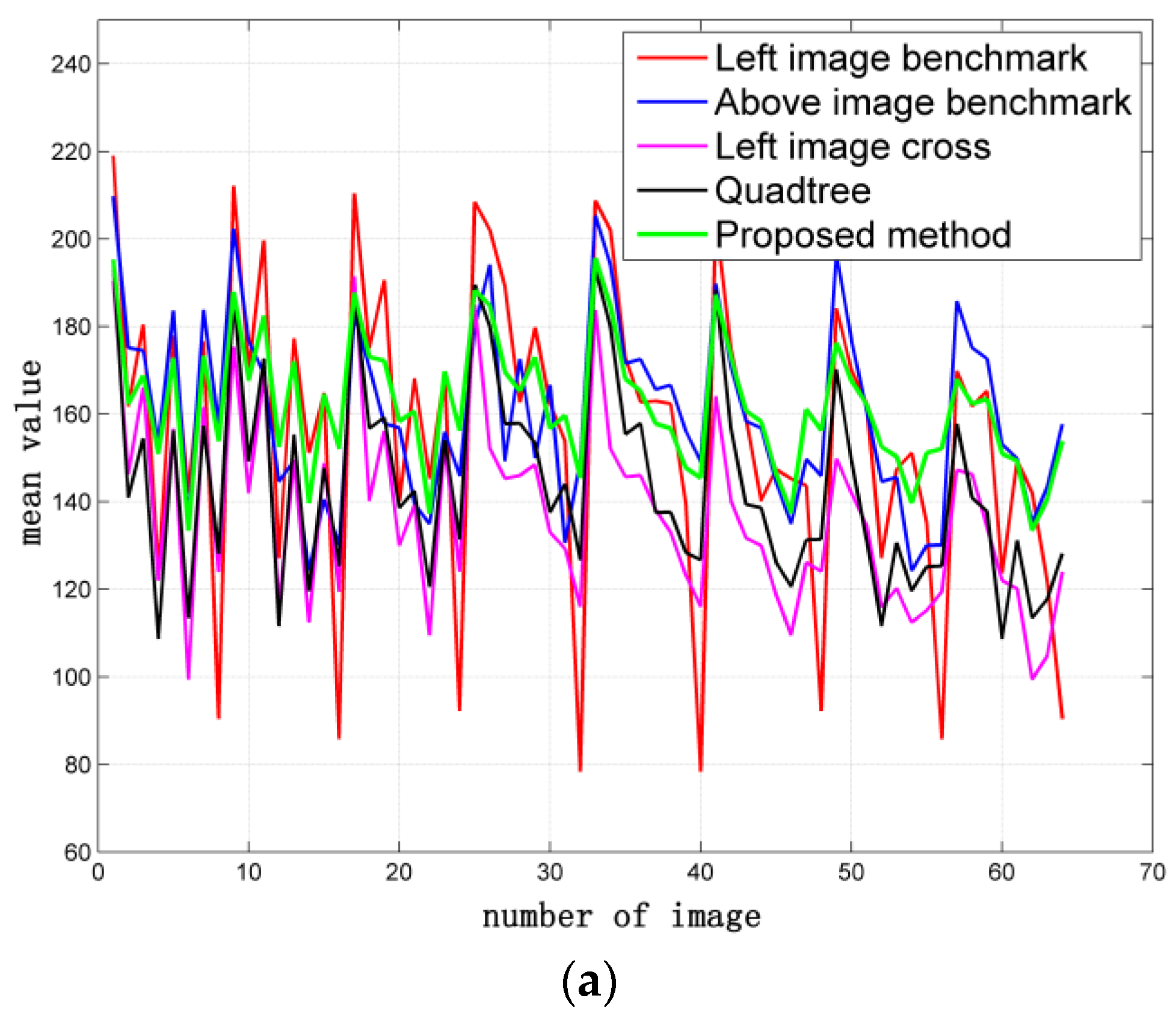

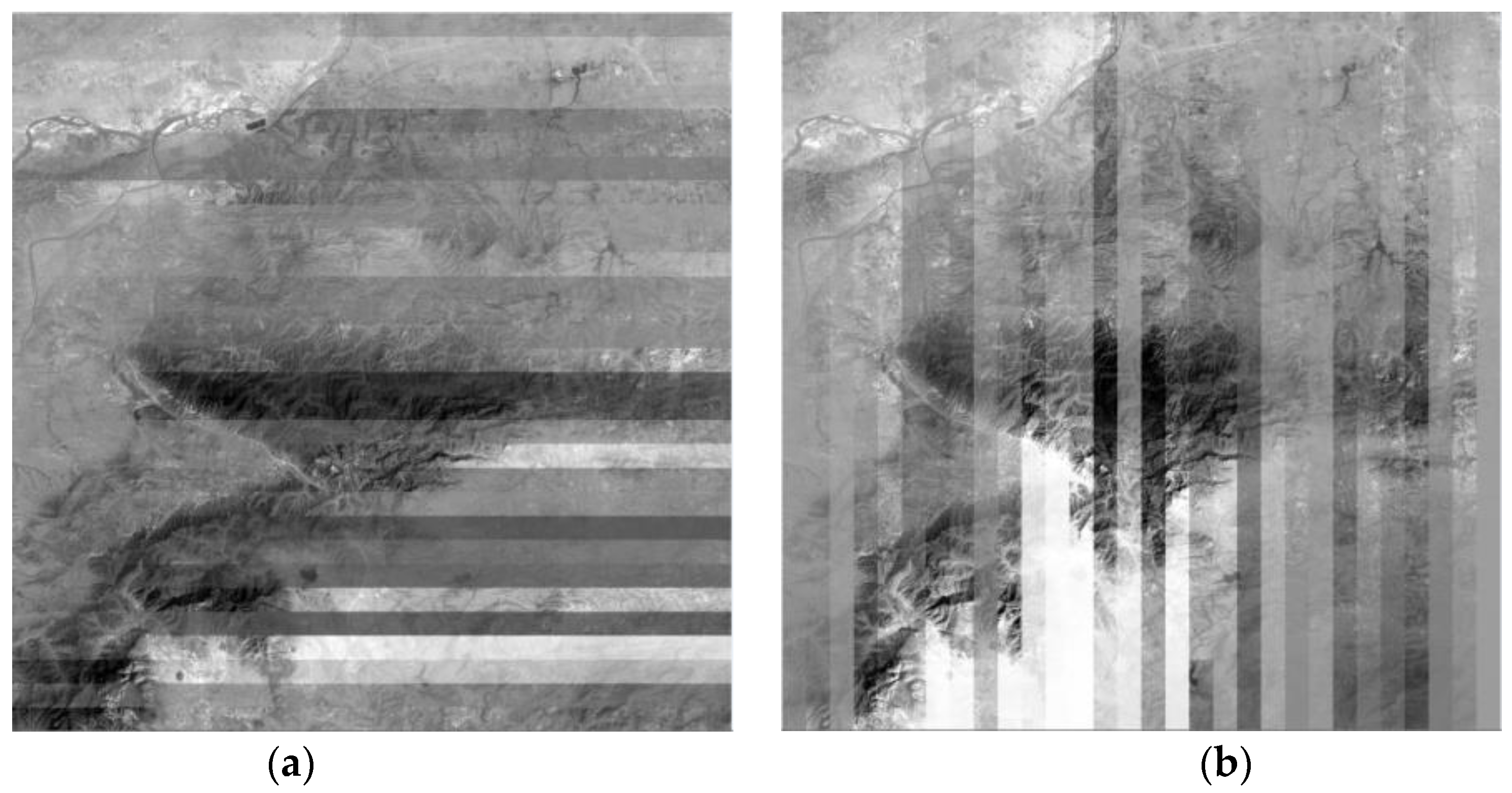
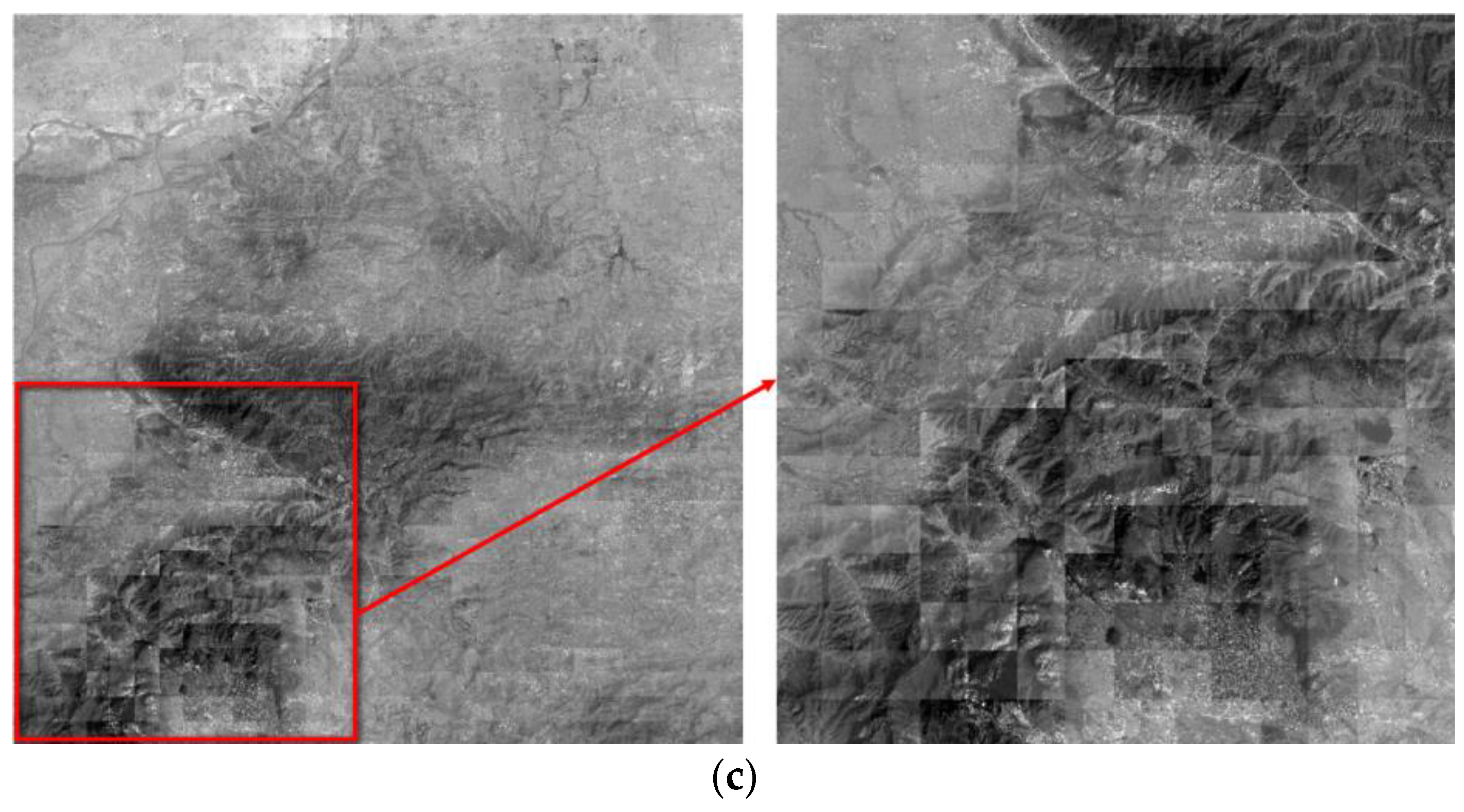
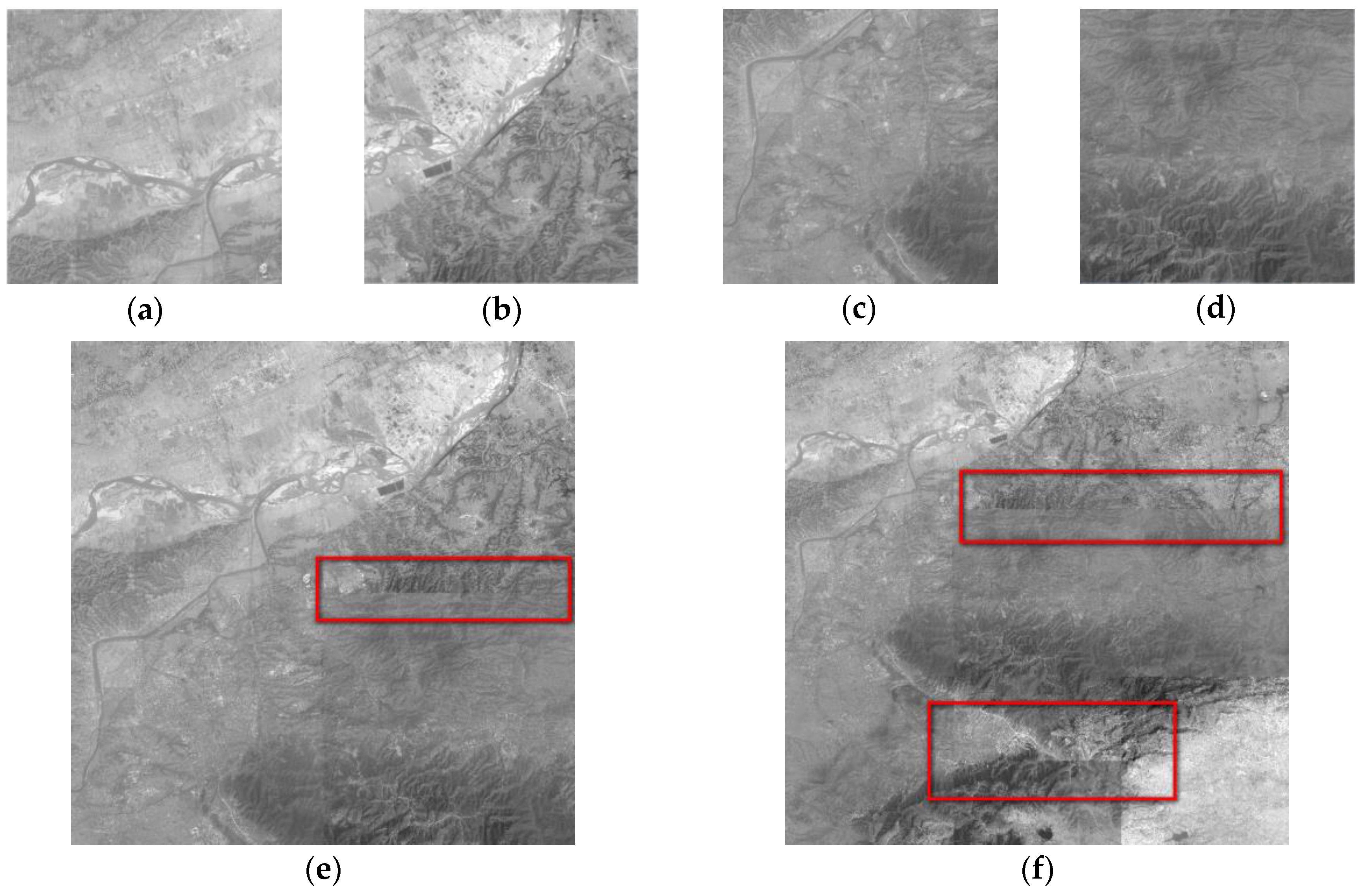
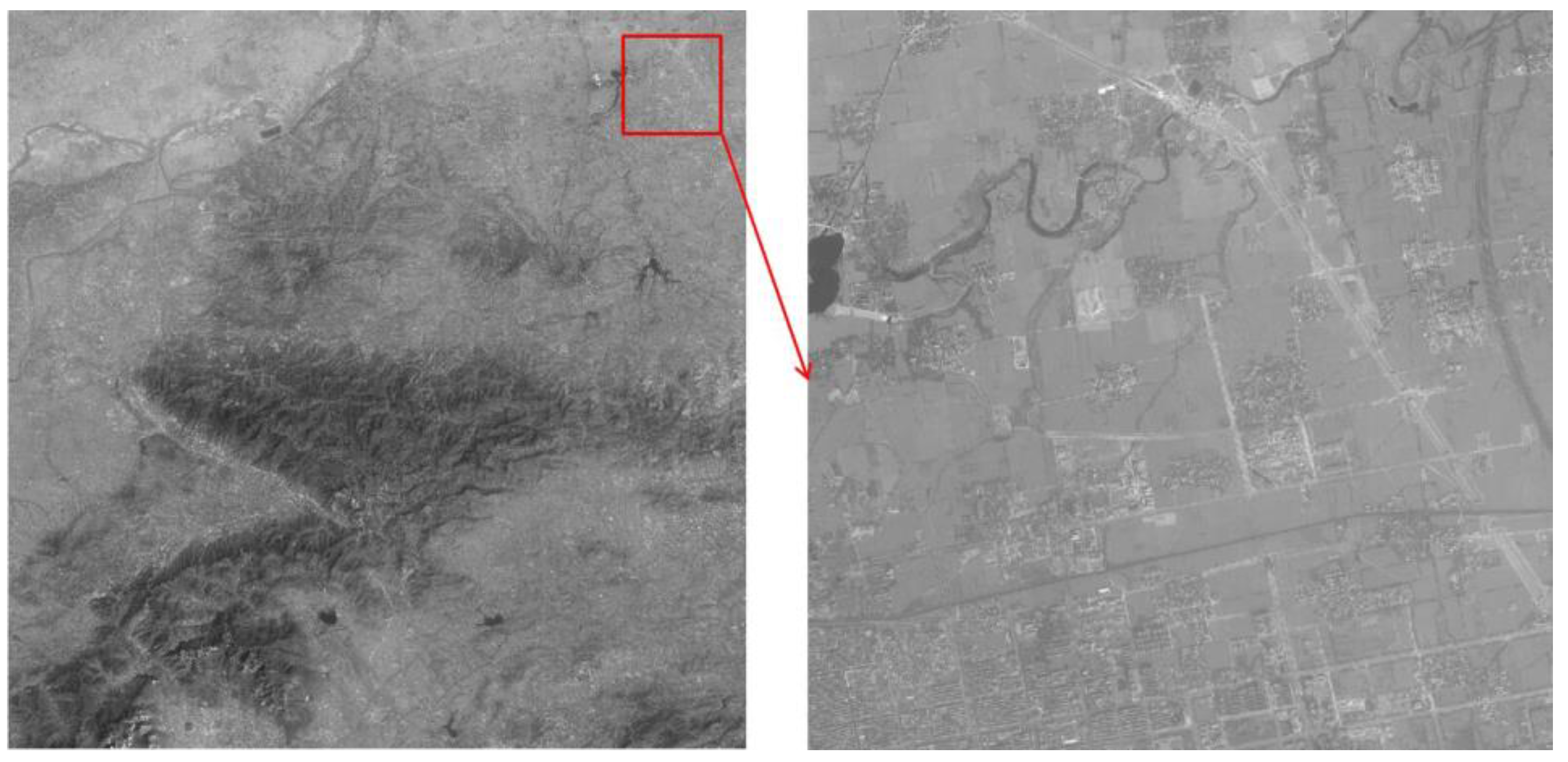
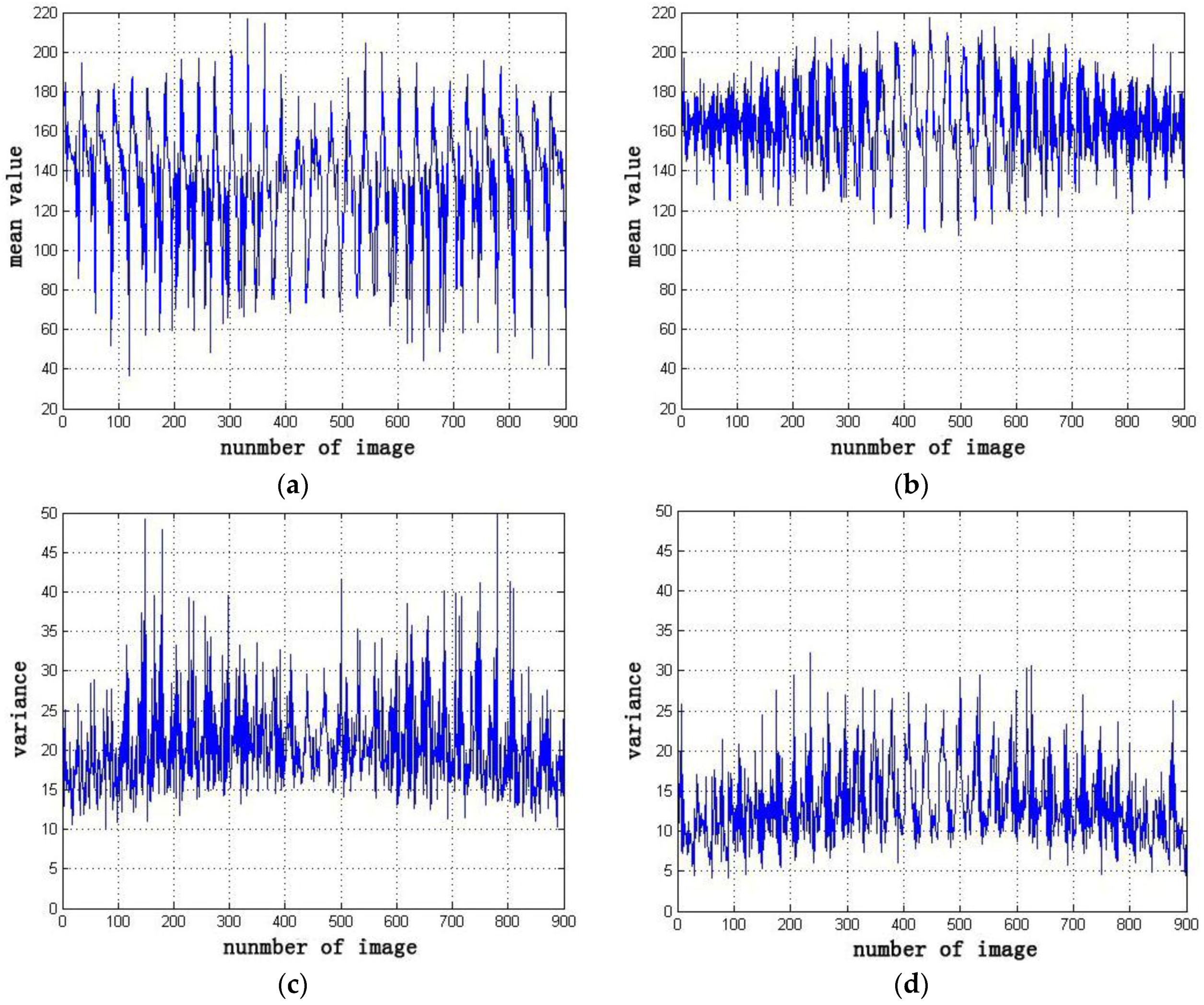
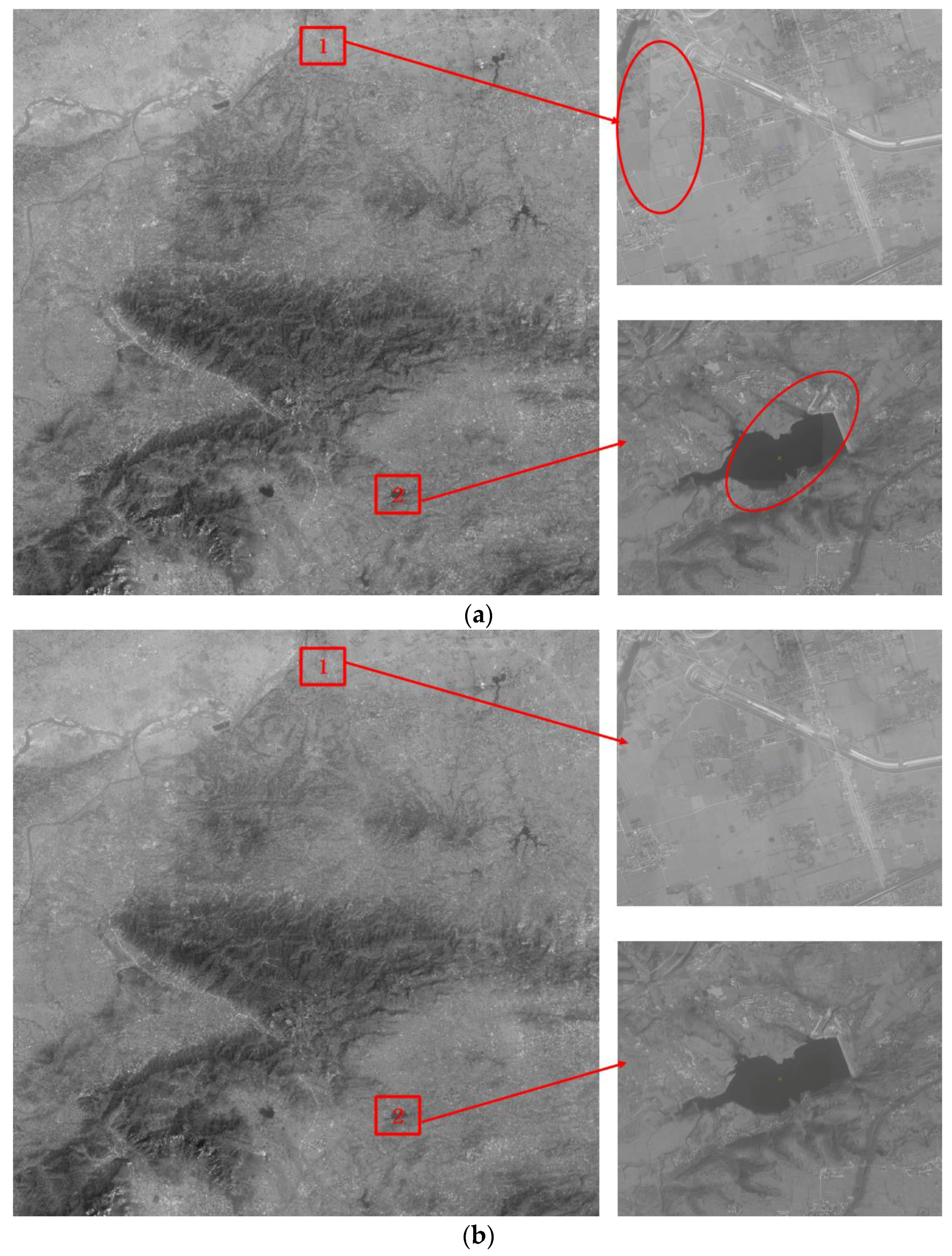
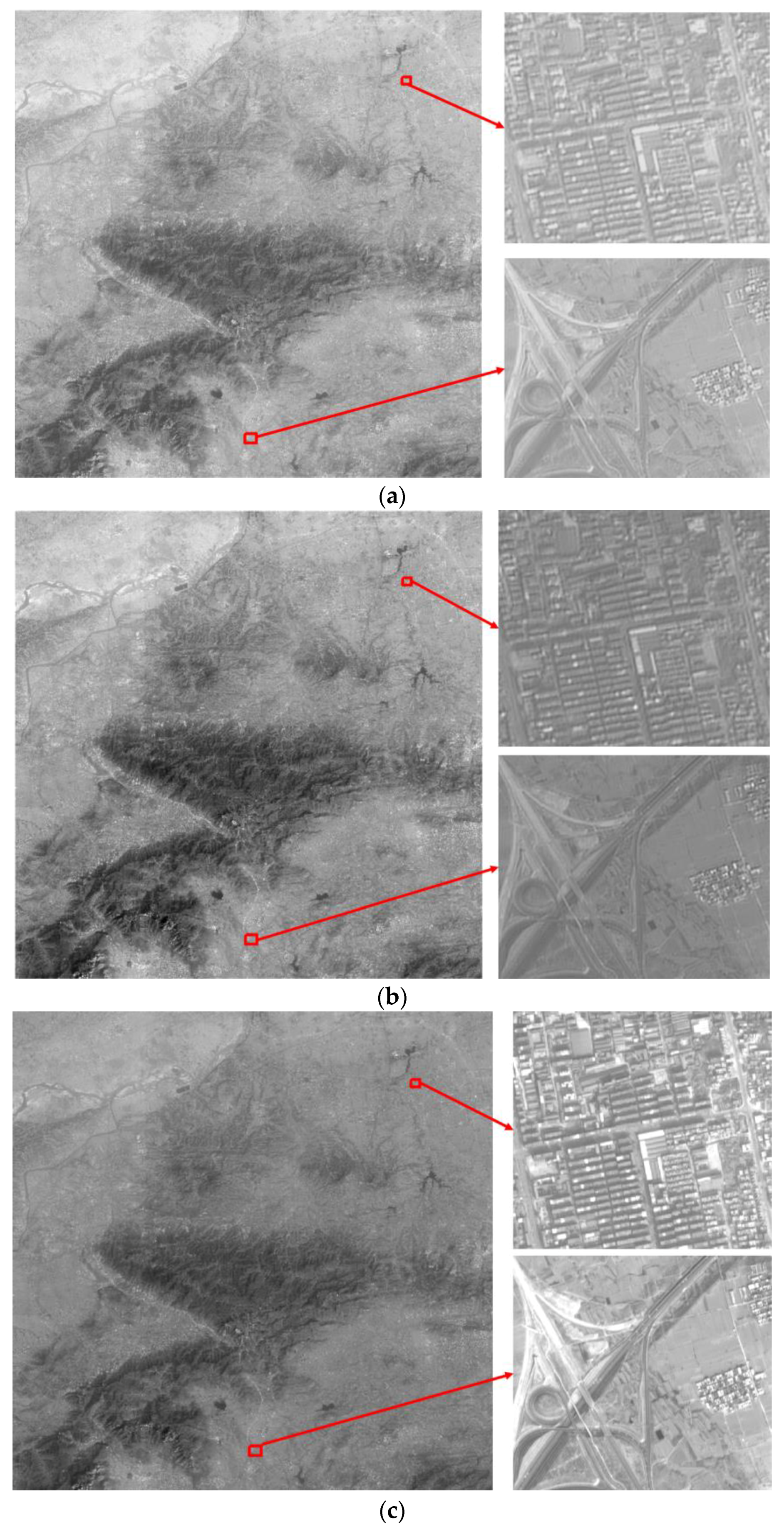
| Image Reconstructed by Different Algorithms | The Value of Q |
|---|---|
| The blind SR reconstruction algorithm | 20.6348 |
| The bicubic interpolation algorithm | 13.0267 |
| Different Image | Average Gradient | Information Entropy | PSNR |
|---|---|---|---|
| Original right image | 3.0945 | 5.8662 | |
| Right image after dodging based on histogram matching | 7.252 | 5.5439 | 42.8714 |
| Right image after dodging based on information entropy | 2.8257 | 5.7266 | 43.0832 |
| Right image after dodging based on Wallis filter | 3.9136 | 5.8812 | 67.2056 |
© 2017 by the authors. Licensee MDPI, Basel, Switzerland. This article is an open access article distributed under the terms and conditions of the Creative Commons Attribution (CC BY) license ( http://creativecommons.org/licenses/by/4.0/).
Share and Cite
Fan, C.; Chen, X.; Zhong, L.; Zhou, M.; Shi, Y.; Duan, Y. Improved Wallis Dodging Algorithm for Large-Scale Super-Resolution Reconstruction Remote Sensing Images. Sensors 2017, 17, 623. https://doi.org/10.3390/s17030623
Fan C, Chen X, Zhong L, Zhou M, Shi Y, Duan Y. Improved Wallis Dodging Algorithm for Large-Scale Super-Resolution Reconstruction Remote Sensing Images. Sensors. 2017; 17(3):623. https://doi.org/10.3390/s17030623
Chicago/Turabian StyleFan, Chong, Xushuai Chen, Lei Zhong, Min Zhou, Yun Shi, and Yulin Duan. 2017. "Improved Wallis Dodging Algorithm for Large-Scale Super-Resolution Reconstruction Remote Sensing Images" Sensors 17, no. 3: 623. https://doi.org/10.3390/s17030623





